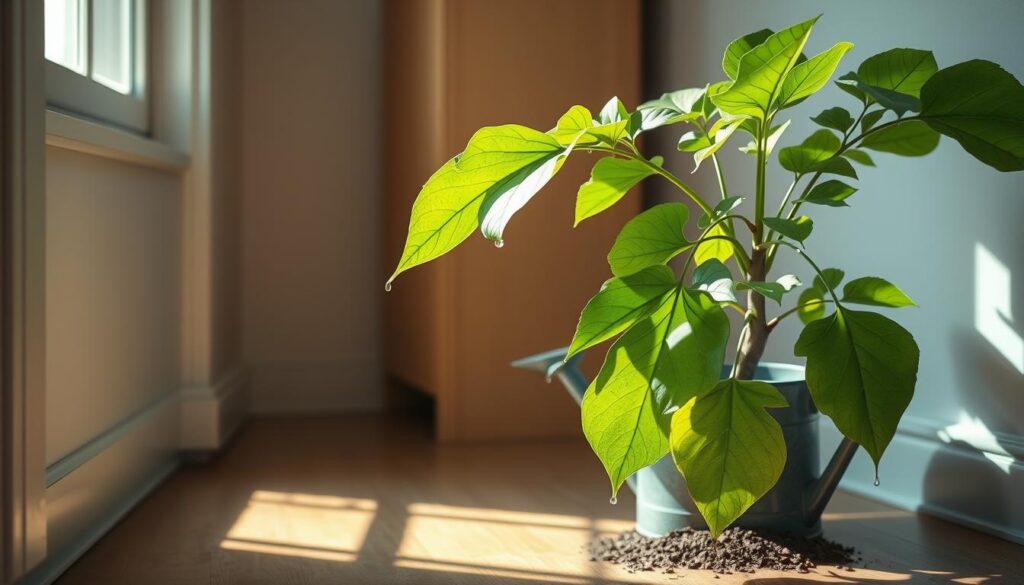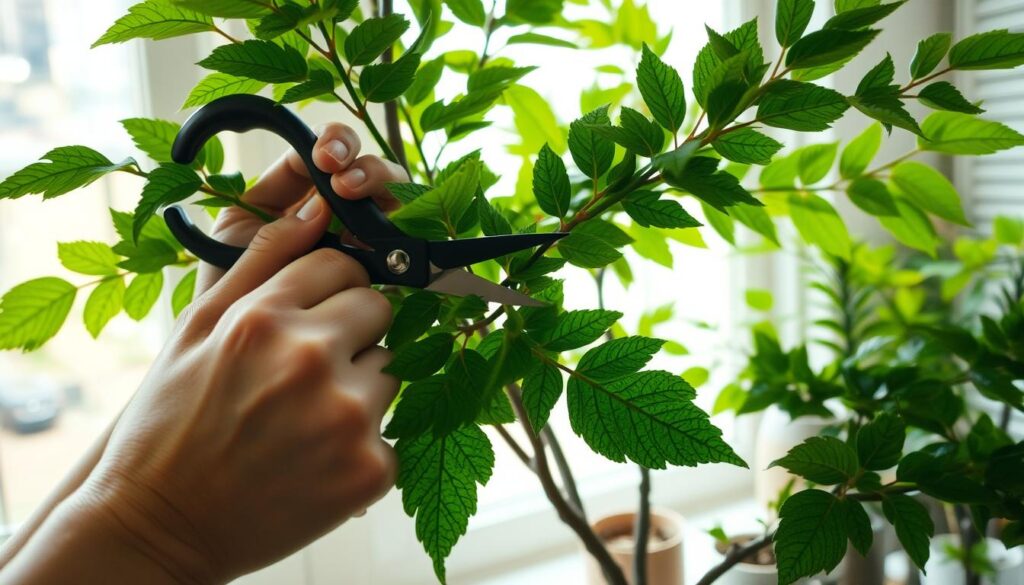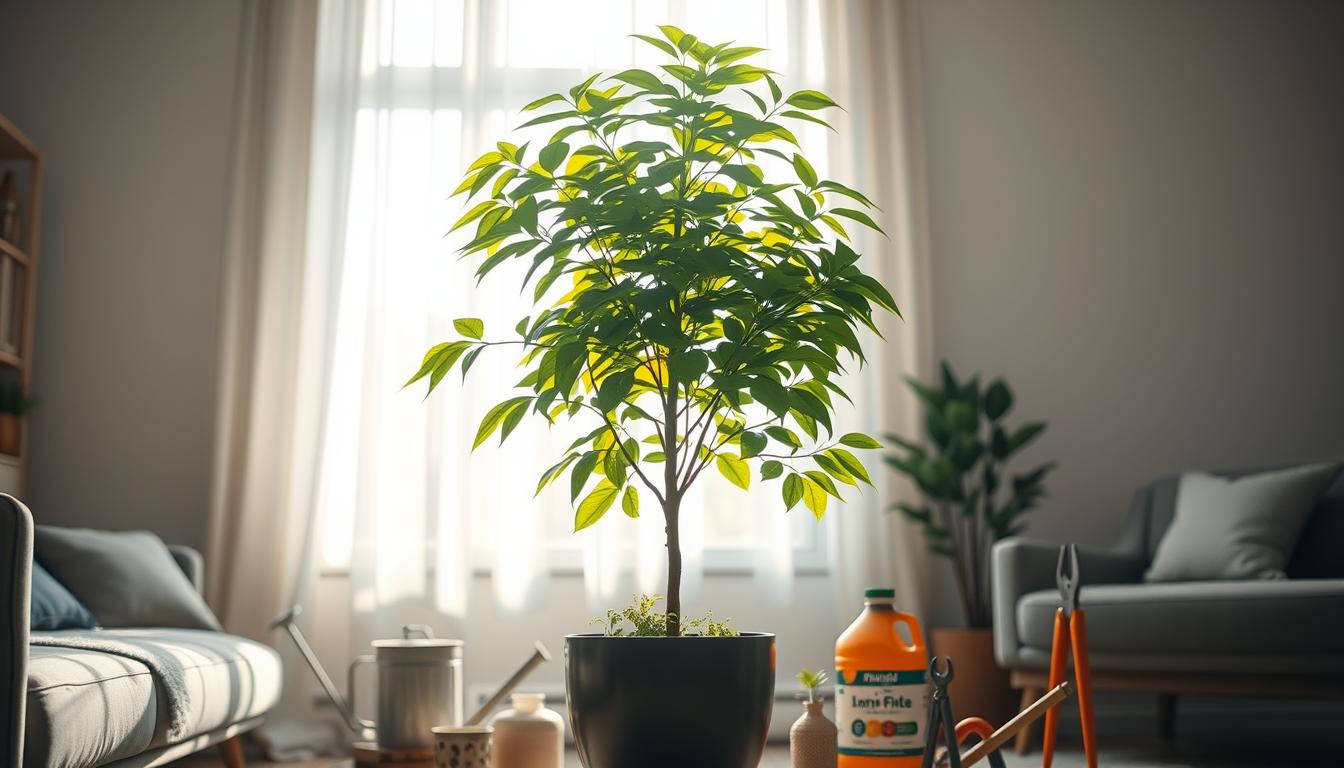Can you keep a low-maintenance houseplant that thrives in low-light and grows up to 10 feet tall? Yes, you can with Umbrella Tree care. These plants are great for busy people or those new to plant care. Learning to care for them is easy.
Umbrella Trees love low light, making them perfect for dark rooms. With the right care, they become a stunning room addition. Knowing how to care for them is key to their health and beauty.
Thinking of adding an Umbrella Tree to your space? They grow up to 10 feet tall and love low light. They’re a favorite for those who want easy-to-care-for plants. Learning about Umbrella Tree care lets you enjoy their beauty and benefits at home.
Introduction to Umbrella Trees
Umbrella Trees are loved for their special leaves and air-purifying powers. They come from warm places and have been around for a long time. With the right care, they can do well in many places.
What is an Umbrella Tree?
An Umbrella Tree is a green tree with special leaves. It likes to grow indoors. It’s easy to take care of but needs some help to stay healthy.
Benefits of Growing Umbrella Trees
Umbrella Trees are good for many reasons. They clean the air and make rooms look nice. Here are some main benefits:
- Air purification: They help remove bad stuff from the air.
- Low maintenance: They don’t need much care, just water and pruning sometimes.
- Aesthetic appeal: Their leaves make any room look beautiful.
Choosing the Right Umbrella Tree
There are many Umbrella Trees to pick from. You can choose from the Schefflera arboricola and Schefflera actinophylla. Think about your space and how much care you can give.
Check the lighting, temperature, and humidity in your home. These things help your Umbrella Tree grow well.
The Schefflera arboricola is easy to care for. It does well in different lights and needs water only sometimes. The Schefflera actinophylla likes bright, indirect light and needs more water. It’s best for those who can give it more attention.
Popular Varieties of Umbrella Trees
- Schefflera arboricola: A compact, low-maintenance option
- Schefflera actinophylla: A taller, more dramatic variety
It’s important to know about the Umbrella Tree soil requirements. You need a potting mix that drains well and slightly acidic soil. You can find Umbrella Trees at nurseries or online. Make sure to buy from a good place to get a healthy plant.
Optimal Growing Conditions
To make your Umbrella Tree happy, give it the right home. It likes bright, indirect light but can handle low light too. For soil, choose something that drains well and is full of organic matter.
What’s best for your plant depends on its needs. But usually, a temperature between 65-75°F works well.
Some important things to think about for your plant’s growth are:
- Humidity levels between 50-70%
- Good air circulation to prevent fungal diseases
- Avoiding extreme temperatures
By giving your Umbrella Tree the right conditions, it will grow well. To keep humidity up, mist it or use a tray of moist gravel. Water it when the top layer of compost is dry, about one-third. Also, feed it with a general-purpose liquid fertilizer once a month.
With proper care, your Umbrella Tree can grow a lot in just one season. This shows it grows fast. By following these tips and meeting its soil and light needs, you’ll create a great home for your plant.
Watering Your Umbrella Tree
Watering your Umbrella Tree right is key. A good guide says to let the soil dry a bit before watering again. Too much water can cause root rot, while too little can make leaves fall off. Think about the room’s humidity and temperature to water it best.
Water your Umbrella Tree once a week, but it might need more or less depending on where it is. Always check the soil moisture first. Use water that’s the same temperature as the room to avoid shocking the roots. Yellow leaves, droopy stems, and a soft trunk mean too much water. Crispy leaves, dry stems, and a wilted look mean it’s too dry.

- Water well, but make sure the soil isn’t too wet
- Wait until the top inch of soil feels dry before watering again
- Use a potting mix that drains well to stop water from staying in the soil
- Don’t let water get on the leaves or crown to avoid rot
By following these tips and watching for signs of too much or too little water, you’ll learn to water your Umbrella Tree perfectly. This will keep your plant happy and healthy.
Fertilization Tips for Umbrella Trees
Umbrella Trees need the right food to grow well. Use a balanced, water-soluble fertilizer. This gives them the nutrients they need. Fertilize once a month when they are growing fast.
Some key points to consider for Umbrella Tree fertilization include:
- Using a balanced fertilizer with a ratio of 20-20-20 (N-P-K) to provide essential nutrients for growth
- Applying fertilizer once a month during the growing season (spring and summer)
- Monitoring the plant’s response to fertilization and adjusting the frequency as needed
For more information on fertilizing indoor plants, visit this guide. It has tips on Umbrella Tree fertilization and other fertilizers.
It’s important to fertilize the right amount. Too much can hurt the roots. Use these tips and the right fertilizers to help your Umbrella Tree grow strong.
| Month | Fertilization Frequency |
|---|---|
| Spring | Once a month |
| Summer | Once a month |
| Fall | Every 6 weeks |
| Winter | No fertilization |
Pruning and Shaping Your Umbrella Tree
Pruning is key to keeping your Umbrella Tree looking good. It’s important to know when to prune. Prune your Umbrella Tree in early spring. This helps it grow new leaves and branches.
For Umbrella Tree pruning tips, use sharp tools to avoid disease. Cut off dead or damaged parts. This makes your tree bushier and fuller.
Pruning has many benefits. It helps your tree grow healthy and strong. It also keeps the tree balanced and stable.
Here are some important Umbrella Tree pruning tips:
- Prune during the growing season, using clean and sharp tools.
- Remove any dead or damaged leaves or stems.
- Cut back overgrown branches to maintain the desired shape.
- Use selective pruning techniques to promote a fuller canopy.
By following these how to prune Umbrella Trees tips, your tree will thrive. Prune often to keep it healthy and looking good.

| Pruning Technique | Benefits |
|---|---|
| Selective Pruning | Promotes bushier growth, fuller canopy |
| Regular Pruning | Promotes healthy growth, prevents legginess |
| Root Trimming | Maintains balanced root-to-crown ratio |
Pest and Disease Management
If you have an umbrella tree, watch out for pests. It’s important to check your plant often. This helps stop pests and diseases from spreading. Pests like spider mites, mealybugs, and scale can harm your tree.
To keep your Umbrella Tree healthy, look for signs of pests. White patches or sticky leaves are bad signs. Use natural stuff like neem oil or insecticidal soap to fight pests.
Here are some natural ways to fight pests:
- Neem oil: a natural insecticide for many pests
- Insecticidal soap: a gentle soap for soft pests
- Keep the tree alone: to stop pests from spreading
By using these tips and natural remedies, you can keep pests away. This will help your umbrella tree stay healthy and strong.
| Pest | Signs of Infestation | Natural Remedy |
|---|---|---|
| Spider mites | White powdery patches on leaves | Neem oil |
| Mealybugs | Sticky substance on leaves | Insecticidal soap |
| Scale | Brown or black spots on leaves | Isolating the tree |
Repotting Your Umbrella Tree
Your Umbrella Tree will grow and need a new home. This is called repotting. It gives the tree fresh nutrients and room for its roots. You should repot every 2-3 years when the roots get too big.
Before you start, pick a potting mix that drains well. Choose a pot that’s just a bit bigger than the old one. This keeps the roots healthy and stops water from pooling.
Here are some important tips for repotting your Umbrella Tree:
- Choose a pot that is 2-3 inches larger in diameter than the current pot
- Use a well-draining potting mix to prevent waterlogging
- Minimize root exposure to air during repotting to prevent stress on the plant
- Water thoroughly after repotting, but avoid overwatering
By following these tips, your Umbrella Tree will grow strong and look great. Repot in the spring when it’s most active. Give it bright, indirect light to help it adjust.
After repotting, keep the soil a bit damp. Don’t move the plant for a few weeks to avoid shock. With the right care, your Umbrella Tree will keep growing and look amazing in your home or office.
| Repotting Frequency | Recommended Pot Size Increase | Soil Mix Ratio |
|---|---|---|
| Every 2-3 years | 2-3 inches larger in diameter | 1 part garden soil to 1 part moistened sphagnum moss |
Troubleshooting Common Issues
Starting with an Umbrella Tree is exciting. But, you might face some common problems. These include leaf drop, yellow leaves, and slow growth. Don’t worry, fixing these issues is easy.
Leaf drop can happen if you water too much or too little. If the soil is always wet, look for soft roots. This could mean root rot. But, if the soil is dry and leaves are droopy, water more often.
Yellow leaves might mean your plant needs more nutrients. Try using a balanced fertilizer to help.
Slow growth can be due to not enough light, bad soil, or not enough food. Make sure your Umbrella Tree gets enough sunlight. Use good soil and feed it regularly for strong growth.
Fixing these problems quickly and giving your Umbrella Tree the best care will help it thrive. You’ll love the beautiful, tropical look it adds to your home.
To check out other Stunning Statement Plants to make an impression with your indoor garden check out our post dedicated here on 10 statement plants for your indoor garden!





Pingback: The Ultimate Guide to Houseplants: 100 Best Indoor Plants for Every Home - Trusted House Plant Guide
Pingback: 10 Stunning Large Indoor Plants for Statement Decor - Trusted House Plant Guide